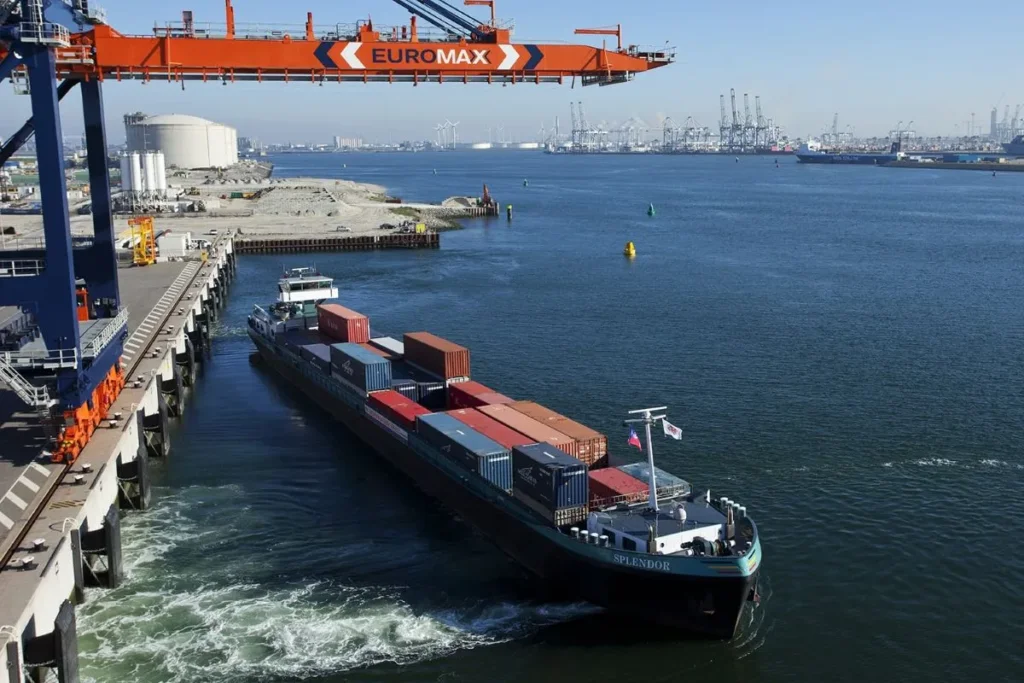In a quarter shaped by shifting trade routes, industrial pressures and labour unrest, Europe’s two largest ports reported diverging trends across cargo segments. While container handling volumes rose at both Antwerp and Rotterdam, overall throughput dropped—underscoring the wider challenges facing bulk cargo markets and the European export sector.
Antwerp’s container traffic grows 4.5%
In Antwerp, container transport emerged as a clear growth engine. The port handled 3.44 million TEUs between January and March, marking a 4.5% increase over the same period last year. Measured by tonnage, container throughput was also up by 4.6%. This Q1 growth builds on momentum from 2024, when the port increased its market share in the Hamburg–Le Havre range to 30.5% and climbed one spot to 14th in the global container port rankings..
“Container throughput served as a key growth engine in the first quarter,” said Jacques Vandermeiren, CEO of Port of Antwerp-Bruges. “Our port is showing resilience and operational reliability. That stability is critical, both for our customers and for the broader economy.”
Despite this success, the port’s total cargo volume fell by 4.0% to 67.7 million tonnes, weighed down by weak performance in the bulk segment. Liquid bulk throughput fell by 19.1%, with gasoline, LNG and naphtha among the hardest hit products. Even so, diesel volumes rose by nearly 24%, and biofuels saw triple-digit growth, offsetting declines in other chemical products.
RoRo volumes at Antwerp also showed modest improvement. While the number of new cars handled fell by over 11%, second-hand vehicle shipments soared by nearly 50%. Truck volumes grew by close to 5%, and unaccompanied freight recorded a 3.1% increase. Notably, unaccompanied traffic to Ireland and Scandinavia grew by 9.4% and 10.3% respectively, even as volumes to the Iberian Peninsula fell by 12.6%.

Image credits @ Port of Antwerp-Bruges
Although March ended with a pilot strike that briefly shut down port access and caused millions in economic losses, the port remained operationally robust. However, another national strike scheduled for 29 April could bring renewed disruption. Port leaders also voiced concern about Europe’s faltering industrial competitiveness, pointing to high energy costs, slow permitting procedures, and burdensome labour expenses. They renewed their call for the implementation of the EU’s proposed Clean Industrial Deal to support long-term investment and stability.
Dirk De Fauw, Mayor of Bruges and Vice-President of the Port’s Board of Directors, emphasised the value of the port’s dual structure.
“These quarterly figures emphasise how valuable the complementarity between Antwerp and Zeebrugge actually is. Thanks to close cooperation and joint investments in infrastructure and innovation, we are continuing to build a strong, integrated port for all of Flanders.”
Rotterdam: more TEUs, but lighter containers
The Port of Rotterdam posted a more modest increase in container handling, with volumes rising to 3.36 million TEUs—a 2.2% year-on-year increase. However, this growth masked an underlying softness in the market, as total container tonnage fell by 1.1%. The discrepancy was largely due to a decrease in the export of full containers, which typically carry more weight. This, in turn, reflected the wider challenges facing Europe’s industrial exporters.
According to Boudewijn Siemons, CEO of the Port of Rotterdam Authority, the first quarter was marked by volatility.
“This volatility has led to uncertainty among companies in the areas of trade and investment. We see this reflected in throughput volumes and the willingness to invest.”
Total cargo throughput at the port fell by 5.8% to 103.7 million tonnes. The steepest declines were in crude oil and mineral oil products, as well as iron ore and coal—sectors that have seen sustained weakness due to lower steel production and the declining use of coal in power generation. Nevertheless, there were some bright spots. Agribulk volumes rose by 22.7%, and the commissioning of a new dry bulk terminal contributed to a 44.1% increase in other dry bulk categories.
Operational disruptions also played a role in slowing container throughput. Adverse weather conditions in January and reduced productivity at the HPD2 terminal led to delays and fewer vessel calls early in the quarter. Conditions improved towards March, but not enough to offset the early losses. Transatlantic traffic also suffered, down by 23.1% after two services were diverted to other ports due to limited terminal capacity. In contrast, container flows from Asia increased by 8.4%, driven by higher consumer imports.
RoRo traffic in Rotterdam declined slightly by 1.8%, facing competition from road transport and subdued economic growth in the UK. General breakbulk, however, improved by over 11%, thanks in part to project cargo such as tubular piles for the Porthos CO₂ storage project.
“Clean industrial deal” urged as EU competitiveness falters
For both ports, the spectre of US import tariffs looms large, though their actual impact has yet to be reflected in the numbers. Nonetheless, port officials on both sides stressed the need for stronger industrial policy at the European level.
“It remains as important as ever that, together with national and European governments, the Port of Rotterdam continues to work towards a competitive European investment climate,” said Siemons.
Meanwhile, Antwerp’s leadership pointed to long-term infrastructure investment as essential for maintaining growth.
“Projects such as ECA (Extra Container Capacity Antwerp) are essential to take steps towards sustainable growth,” said Johan Klaps, the port’s Board President.
Container strength offers hope, but uncertainty looms
Although both Antwerp and Rotterdam demonstrated notable resilience in container volumes, their first-quarter performance underscored how vulnerable European ports remain to geopolitical tensions, trade uncertainty and industrial stagnation. While investments in infrastructure and innovation are underway, the coming months may prove even more testing—particularly if labour actions persist or protectionist measures gain ground.









